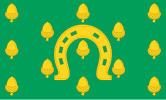
Priory Church of St Mary, Bridlington, grid reference TA177680, commonly known as Bridlington Priory Church is a parish church in Bridlington, East Riding of Yorkshire, England, in the Diocese of York. It is on the site of an Augustinian priory founded in 1113 which was dissolved during the Dissolution of the Monasteries. In 1951 it was designated a Grade I Listed Building.

The Diocese of Leicester is a Church of England diocese based in Leicester and including the current county of Leicestershire. The cathedral is Leicester Cathedral, where the Bishop of Leicester has his episcopal chair.
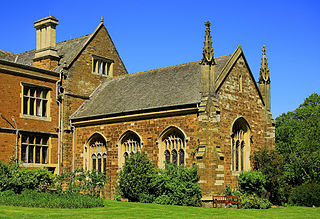
Launde is a civil parish in the Harborough district of Leicestershire, bordering Rutland. The parish is the site of Launde Abbey. It gives its name to an electoral division of Leicestershire that stretches all the way from Scraptoft, Thurnby and Stoughton, near Leicester, to the border with Rutland. The civil parish population is included in the civil parish of Loddington.
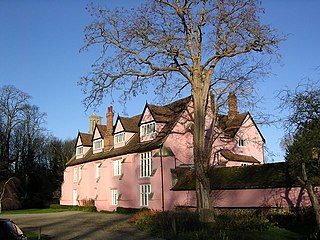
Clare Priory is a religious house in England, originally established in 1248 as the first house of the Augustinian Friars in England. It is situated on the banks of the River Stour, a short distance away from the medieval village of Clare, Suffolk. The friary was suppressed in 1538 and the property passed through many hands until it was again purchased by the Augustinian friars in 1953. Today the Priory offers modern retreat facilities for guests.

Walsingham Priory was a monastery of Augustinian Canons regular in Walsingham, Norfolk, England seized by the crown at the Dissolution of the Monasteries under King Henry VIII.

Gregory Cromwell, 1st Baron Cromwell, KB was an English nobleman. He was the only son of the Tudor statesman Thomas Cromwell, 1st Earl of Essex and Elizabeth Wyckes.
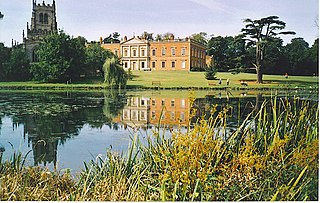
Staunton Harold is a civil parish in North West Leicestershire about 3 miles (5 km) north of Ashby-de-la-Zouch. The parish is on the county boundary with Derbyshire and about 9 miles (14 km) south of Derby. The 2011 Census recorded the parish's population as 141.

Withcote is a small parish currently comprising a number of scattered dwellings in Harborough, a local government district of Leicestershire. The population is included in the civil parish of Braunston-in-Rutland.

Loddington is a village and civil parish in the Harborough district of Leicestershire. It is on the county boundary with Rutland, and the nearest town is Oakham in Rutland, 6 miles (10 km) to the northeast.
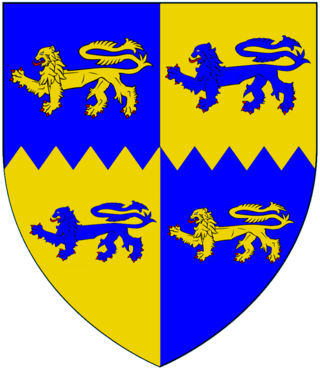
Henry Cromwell, 2nd Baron Cromwell, the son of Gregory Cromwell, 1st Baron Cromwell and Elizabeth Seymour, was an English peer during the reign of Elizabeth I. He was the grandson of Henry VIII's chief minister, Thomas Cromwell, 1st earl of Essex, nephew of the Protector Somerset and first cousin of Edward VI.
Richard Basset was a royal judge and sheriff during the reign of King Henry I of England. His father was also a royal justice. In about 1122 Basset married the eventual heiress of another justice; the marriage settlement has survived. In 1129–30 Basset was co-sheriff of eleven counties. Basset and his wife founded a monastic house in 1125 from their lands, which before the donation were equivalent to 15 knight's fees.

Kirby Bellars Priory was a small priory of Canons Regular of Saint Augustine in Leicestershire, England. It is now the Church of England Parish Church of Saint Peter's serving the village of Kirby Bellars.

Launde Priory is a former Augustinian priory in Leicestershire, England. Its successor Launde Abbey is used as a conference and retreat centre by the Church of England dioceses of Leicester and Peterborough.
William Basset was an Anglo-Norman administrator and justice.

The Abbey of Saint Mary de Pratis, more commonly known as Leicester Abbey, was an Augustinian religious house in the city of Leicester, in the East Midlands of England. The abbey was founded in the 12th century by the Robert de Beaumont, 2nd Earl of Leicester, and grew to become the wealthiest religious establishment within Leicestershire. Through patronage and donations the abbey gained the advowsons of countless churches throughout England, and acquired a considerable amount of land, and several manorial lordships. Leicester Abbey also maintained a cell at Cockerham Priory, in Lancashire. The Abbey's prosperity was boosted through the passage of special privileges by both the English Kings and the Pope. These included an exemption from sending representatives to parliament and from paying tithe on certain land and livestock. Despite its privileges and sizeable landed estates, from the late 14th century the abbey began to suffer financially and was forced to lease out its estates. The worsening financial situation was exacerbated throughout the 15th century and early 16th century by a series of incompetent, corrupt and extravagant abbots. By 1535 the abbey's considerable income was exceeded by even more considerable debts.
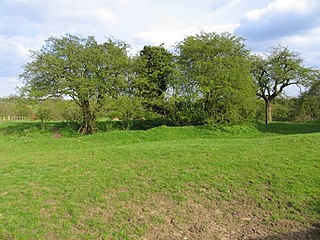
Brooke Priory was a minor house of Augustinian monks in Brooke, Rutland. It was a cell of St Mary's Abbey, Kenilworth.
The following is a timeline of the history of the city of Leicester, the county town of Leicestershire, in England.
Mary Paulet, Lady Cromwell was an English noblewoman, the daughter of John Paulet, 2nd Marquess of Winchester of Basing, Hampshire and his first wife Elizabeth, daughter of Robert Willoughby, 2nd Baron Willoughby de Broke by his second wife, Dorothy, daughter of Thomas Grey, 1st Marquess of Dorset.
















